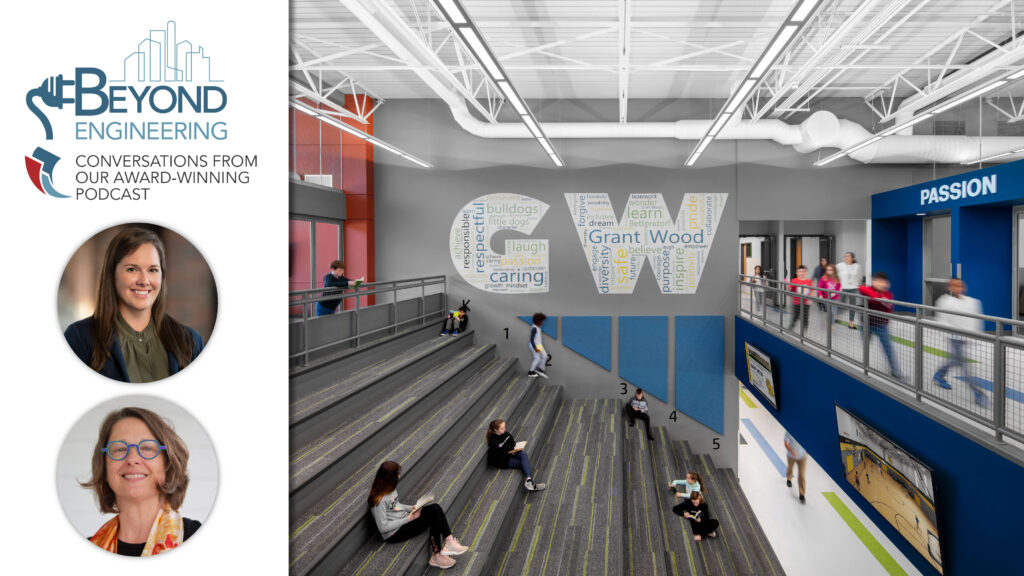
How Do RTM & Legat Architects Take on Environmental Responsibility?
When RTM Engineering Consultants and Legat Architects partner to design a school, we work according to the philosophy that the whole world is a classroom, that learning environments and our global environment should be connected.
I recently sat down with Robin Randall, a Legat principal and the firm’s Director of Learning, to discuss our collaborative approach to remodeling and renovating dozens of educational facilities in Illinois and Iowa. We strive to lay groundwork for sustainable environmental practices by administrators, teachers and, of course, students.
Here are some highlights from that conversation with Robin.
Robin, why is environmentalism so important to you?
I am definitely a hippie at heart, and in the ‘70s, I was very much interested in environmentalism. I come from a family of environmentalists. I went to Ball State University and my undergrad degree was in environmental science.
My drive is to save the planet, but it’s also to educate others how to do that. 60-80% of the carbon footprint comes from a building. Legat is super excited that we’re just now creating our first “net zero” building, and we’re planning others. Maybe a “net positive” building in the future.
For those who aren’t familiar with the phrase “net zero” please explain what that means in design terms.
“Net zero” energy means that a building is creating as much energy as it’s using on-site.

First, you want to use as little energy to heat and cool the existing building. You want your systems to be as efficient as possible. You can use geothermal systems, you can use other systems, but you want to create the system that is most efficient.
Then, it’s just a math equation. You take whatever energy the building needs to use, and then you balance that with renewable energy. Often, it’s solar. It can be wind. It can be biofuels and other elements to get to that net zero. Basically, it’s a balanced equation. Whatever energy you need, you’re producing.
Net positive is actually generating more energy on-site than you’re using, giving back even more and taking care of your community.
What I like about the net zero concept is that you either are or you aren’t. You design a building, and you intend there to be an equal equation where you’re producing as much energy as you’re using. That is evaluated in the first 18 months of occupancy so that it’s just black and white.
Now, let’s discuss another word associated with environmentalism: Sustainability.
Schools for K-12 and higher education should be designed for longevity, to sustain a connection between the environment inside the buildings and the environment surrounding the building.
So, let’s talk about two schools we renovated in Iowa.
Both of them are replacement schools for the same district. They were built while the existing schools continued functioning. They’re in areas of high visibility, so they’re designed to be seen from all directions as a reflection of the central role they play in the community.
areas of high visibility, so they’re designed to be seen from all directions as a reflection of the central role they play in the community.
They needed some specialized spaces for the staff and kids. For example, we created a hoteling environment for teachers who come in just for a day, or two times a week. There’s a collaborative conference room for educators in that space. It’s something we’re replicating for other schools in the region.
The library has a maker space, and the cafeteria doubles as a STEM lab. So, there’s water and storage available for messy projects.
One of the most sustainable ways to design is creating spaces that can be used in many different ways.
Both were built on hillsides along the Mississippi River Valley. So, their positions enabled us to bathe learning stairs, libraries, and common areas in natural light.
 That exposure to the exterior is a subtext to learning about the environment. Students are learning environmental issues in a subconscious way just by being in those environments and appreciating the outdoors.
That exposure to the exterior is a subtext to learning about the environment. Students are learning environmental issues in a subconscious way just by being in those environments and appreciating the outdoors.
What research proves is that we protect the things we love. If you fall in love with the outdoors, and if you fall in love with your environment, you’re more likely to protect them.
Robin, if you had to choose one message for engineering pros to take away from this conversation, what would you say?
We need your help to define what sustainable systems are. How can we get to net zero? How can we get to net positive in a practical way that makes sense for our clients? Collaborate with us to find the best way.
There is much more to my chat with Robin Randall. Hear more of our conversation about meaningful partnerships in this episode of RTM’s Beyond Engineering podcast:
Are you launching a career as an engineering technologist? Or are you a proven professional in the engineering field looking for new ways to advance your career?
Consider joining RTM Engineering Consultants. We support your growth as you sharpen technical skills, deepen business experience and diversify capabilities across services, specialties and markets from coast to coast. Our mentors are seasoned professionals, committed to sharing expertise and passing knowledge from one generation of engineers to the next. Learn why industry authorities consider RTM a great place to work, grow and advance. Explore employment opportunities.

 By:
By: